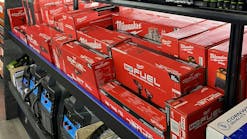Technicians come to you to buy stuff, not to order stuff. So, you need to keep a solid inventory on your truck.
When a customer asks you for a tool, they want to take it to their work bay and put it to work -- today. With a few exceptions, they don’t want to wait. If they were willing to wait, they might order it online. And you don’t want that.
If you don’t stock it, you can’t sell it. But you can’t stock everything. That’s the delicate balancing act of being a tool dealer: you need full inventory, yet you need to know what to stock and what to special order.
“When you’re first starting out you have a good tendency to want to buy and stock everything,” says 12-year Cornwell Dealer Andrew Phelps of Westminster, MD. “You get tired of telling customers you need to order it. It wears on you. But you can bury yourself real quick trying to overbuy inventory and end up putting yourself out of business.”
Overstocked beats under-stocked
I polled a dozen tool dealers on inventory. Half had 10 or more years of experience, half had been a dealer less than a decade. Two-thirds of the veteran dealers said they were overstocked. But none of the dealers with 10 years or less experience were overstocked. Although it seems counterintuitive, perhaps the more seasoned dealers had learned that overstocked is better than understocked, and had accumulated the financial resources to carry higher levels of inventory.
But just having a lot of product on your truck or stored in your garage is not a guarantee of success. In fact, tying up too much cash is not a good idea. Smart buying is more important. Successful dealers seemed to be the ones that stock up on deals at annual tool expos, buy on special or buy in bulk so they can maximize their margins. The math is simple: Lower costs equal higher profits.
To everything turn, turn
Inventory turn is a key measurement in retailing. It measures how effectively you are using your assets. To calculate inventory turn, divide annual sales by average inventory. There is no hard and fast rule in tool distribution on what a turn should be. But in theory, one turn is too low. And six turns is excellent.
About half of the dealers I polled did four or more turns a year. Lower turns concern me, but not as much as those that had no idea what their turn was. That’s scary. If you don’t know your numbers off the top of your head, you don’t have a pulse on your business.
Cornwell dealer Phelps is successful at doing about five turns a year. I give him a gold star for using his assets well to make money. He is textbook.
The other aspect of inventory is keeping most of your inventory on the truck and not in storage. Having too many items in storage is tying up inventory and cash.
“I really don’t have anything at the house if there isn’t one on the truck,” Phelps says.
He clarifies that there are big items that he doesn’t carry on the truck like welders and toolboxes. But he tries to keep at least one item from the product category on his truck. He has about 75 percent of his inventory on his truck and the rest at home.
Margin matters
One of the keys to success is not just turning your inventory, but maintaining a strong margin on the items you sell. A good way to do that is to shop for deals and stock up when items are on special.
“I spend probably 25 percent of my annual budget at the [Cornwell Tools] Rally -- to get better deals,” Phelps says. “I don’t have a problem sitting on it all year to make the extra margin on it.”
Some stuff from the rally he promotes out as soon as he gets back to work. He also tries to buy extra items to inventory so he can increase his margins on day-to-day orders, too. But spending so much money at one time can be stressful.
“Even after 12 years in the business, when I look at my account and see an $85,000 tool bill after rally there’s a little antacid involved,” Phelps says.
You can’t have it all
You can’t carry everything on your truck. There isn’t the room or the cash to do that. So, there’s a balance between what you stock and what you special order.
Using his previous year’s sales report from Cornwell’s software, Phelps says he “spits out the top three pages” of his annual sales report to be sure he has the most sold items stocked. Phelps also has regular conference calls with other Cornwell dealers and determines what his fellow dealers find hot and tries to stock those items.
Keeping an accurate tally on your inventory is key. If you find a deal on an item, you need to know how many you have in stock already. You don’t want to overload on an item just because your inventory count is off. This ties up cash and space.
Know what’s new
The dealers I polled said they primarily decide what new items to stock based on their flag’s tool expo and monthly flyer. Flag resources can also provide dealers with special discounts and other incentives.
The second method dealers use to keep up-to-date is trade magazines like Professional Distributor. Outside sources can give dealers an objective view of what innovations are happening nationwide.
The third most popular way dealers find new products is customer requests. This is a good way to find out what is actually popular in the work bay. Your customers will tend to be the best gauge of what will sell well on your route.
Keep it fresh
Sometimes, it’s not just about having new inventory. Rotating your stock is important, too. Moving items around the truck can sometimes help move more merchandise.
Phelps freshens his inventory simply by moving it around. Often customers will be surprised to find a ‘new’ tool that he had had on a different shelf for months.
“Every four to six months, take everything from the top shelf and put it on the bottom shelf and rotate everything and you’ll be amazed,” he says.
Knowing what makes you money should also tell you where to place your stock.
Hardlines tend to be the biggest moneymakers. So, you should place your hardlines in the prime real estate on your truck: close to the door, on the right side, at eye level. Merchandise your products well. Take them out of the box as appropriate. Post key selling points nearby. Remember: the more likely a customer is to see it, the more likely you’ll sell it.
Making money takes spending money wisely
“This year, I bought the same air tools I’ve bought at rally every year,” Phelps says. “But nine months later, I found myself with a couple thousand dollars of air tools on my truck. I didn’t know what I was going to do.”
Customers are still buying air tools, but there’s definitely a shift from air tools to cordless tools. If you don’t see the trend, you could end up with a lot of expensive, dusty boxes taking up space on your truck. Seeing the shifts and knowing the trends is important.
“Over the course of a decade I’ve seen things change and I try to pay attention and keep up on it,” Phelps says. “I have noticed from when I started to now, there are a lot of things I stock differently … but most of the stuff I stock are your normal everyday items like socket sets, wrenches, impact guns, cordless tools, drill bits ... things like that.”
Thinking big can pay off big
“Don’t be afraid to put a big ticket item on the truck every once in a while,” Phelps says. “Get a tire balancer. Get an air compressor. … You’d be amazed that when people see it you’ll sell it.”
One Friday, Phelps put a $700 welder on his truck and sold it the same day, along with a bunch of extra supplies.
“I never used to stock welders and I never used to sell welders,” Phelps says. “I now have five welders in stock.”
Customer loyalty only goes so far
Some dealers think building customer loyalty can make up for inventory gaps. But if every other item your customers ask you for are special orders, you may need to take a hard look at the items and dollars in your inventory.
Loyalty isn’t always guaranteed. Today, more customers realize they can often get the tools they need from another dealer, a bricks and mortar store or online. So if you don’t have a popular tool in stock, a customer may not wait until next week.
Out with the old
One way to manage inventory is to find old or obsolete stock and dump it at clearance to free up cash and space for newer or more popular items.
“I actually sold an item the other day that had been on this truck for six years,” Phelps says. “The crazy thing is [the customer] asked for it. He said ‘Please tell me you have one.’ We had to dig around on the bottom shelf in the back for a while to find it … He was ecstatic when we found it. But I think I was more happy than he was to get rid of it.”
Keeping all together
Overall, managing inventory is juggling act. It’s replenishing key inventory immediately. It’s spotting the trends and knowing how to change your buying patterns according. It’s keeping the stock and the layout of your truck fresh. It’s knowing how much is enough to inventory. And it’s buying smart so you maximize your profits.


